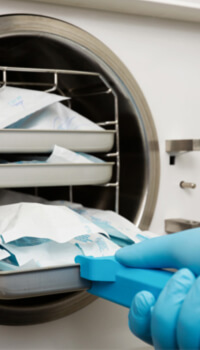In the demanding world of dentistry, the sterilization of instruments and equipment is a fundamental priority to ensure the safety and well-being of patients and professionals. Autoclaves play a crucial role in this process, providing an effective and reliable solution for the elimination of microorganisms. In this article, we will delve deeper into what an autoclave is, how an autoclave works, as well as analyzing the aspects you should consider when choosing the autoclave that best suits your dental clinic.
Maintaining sterile instruments is one of the most important processes, and having adequate dental equipment is essential to provide high-quality and safe dental care. Expand your knowledge of autoclaves to improve your work performance, increasing your confidence that your tools are sterilized to the highest level!
Don't miss it and read on!

What is an autoclave and what is sterilization?
Autoclaves are devices whose function is to sterilize equipment and tools using steam at high temperature and pressure. Those commonly used in dentistry are usually the size and shape of a microwave and are typically made of stainless steel due to its resistance to corrosion and high temperatures.
Sterilization is the process by which certain materials are subjected to eliminate microorganisms that may be present with the primary objective, in the case of dental clinics, to avoid cross-infections between patients.
How does an autoclave work?
Firstly, we need to prepare the material or load to be sterilized in the autoclave (always taking into account the manufacturer's instructions for the instruments, as not all can be sterilized in an autoclave). This load not only affects the type of program or cycle we will select, but it can also determine what type of autoclave we need in our clinic. We can differentiate four types of load according to the EN-13060 Standard:
- Solid load: objects without porosity and with a surface that does not present characteristics such as cracks or grooves. In this classification, we can find, for example, dental forceps.
- Porous load: objects with absorbent materials, for example, surgical gowns.
- Hollow load >5 mm (type A): objects with hollow spaces with an internal diameter greater than 5 mm, for example, contra-angle.
- Hollow load <5 mm (type B): objects with hollow spaces with an internal diameter less than 5 mm, for example, suction cannulas.
After selecting, preparing and placing the load inside the autoclave, the door of this one is closed hermetically so that it can reach the necessary pressure and temperature for the sterilization process safely.
Once the necessary cycle has been selected for the type of load, steam is generated from an internal or external steam generator, expelling the air from the inside as this penetrates the interior of the chamber. If a pre-vacuum cycle is used, the air from the inside will be expelled before the steam water is introduced, allowing for greater penetration and therefore a better sterilization in porous materials.
When the interior reaches the target pressure and temperature, they are maintained for a determined time that usually oscillates between 15 and 30 minutes, depending on, among other things, the type of load and temperature. This time allows the autoclave to destroy microorganisms, spores, and other pathogens present in the load.
Once the time is up, the internal pressure is released in a controlled manner, either through a cooling fan or by allowing it to cool naturally. Some autoclaves have the option to program a drying cycle to eliminate residual moisture from the load, which is really useful when sterilizing instruments that need to be absolutely dry before use, such as surgical instruments.
*/Curiosity Dentaltix!
Did you know that NASA uses autoclaves to sterilize space probes before sending them to other planets? This process is essential to avoid biological contamination of other celestial bodies with terrestrial microorganisms, a principle known as planetary protection.
What aspects should be taken into account when choosing an autoclave?
Autoclaves are not only used in the world of dentistry, but we can also find them in the medical, pharmaceutical, veterinary industries, or even in tattoo studios and beauty and aesthetics centers. However, not all of them require the same characteristics in an autoclave. So, what characteristics should I consider when choosing an autoclave for a dental clinic?
Type of autoclave
This categorization depends mainly on the steam penetration capacity of the instruments, so it is important to take into account the type of load we will need to sterilize on a daily basis.
- Class N Autoclaves (Naked): It is the most basic type of Autoclaves. Class N autoclaves are only suitable for the sterilization of solid, unwrapped loads. Their steam penetration capacity is more limited, e.g., they do not allow the removal of the internal air before sterilization (pre-emptying), which makes them unsuitable for all types of instruments and therefore may not be very useful in the dental clinic.
- Class S Autoclaves (Specific): Although their application is greater than Class N, they are still less functional than Class B. They allow for the sterilization of solid instruments (wrapped and unwrapped) and wrapped porous loads, since the steam penetration capacity is still not sufficient.
- Class B Autoclaves (Big): They are the most advanced and versatile and are recommended for a dental clinic according to the European Standard 13060. Class B autoclaves use a pre-sterilization vacuum system that removes air from the chamber before steam penetration, ensuring perfect sterilization of all types of instruments, including porous ones with blind spots, such as turbines or contra-angles.

Autoclave capacity
.The capacity of an autoclave is determined by the number of liters it can hold. If the number of instruments we need to sterilize is high, it's recommended to have an autoclave with high capacity, for example, 29 or even 45 liters. On the other hand, if we have few instruments to sterilize, one with 8 or 12 liters might be sufficient.
It's also important to consider the space available in the clinic, since the liter capacity of an autoclave is directly related to its size, as well as the operating cost it generates.
Sterilization Cycles
The most modern autoclaves offer a wider range of options than conventional ones, providing basic sterilization cycles along with new ones, such as rapid programs or specific ones for certain types of loads, and in some cases, allowing for the creation of customized cycles by the specialist themselves. This translates to greater efficiency and ease of use.
An important cycle for autoclaves used in dental clinics is the drying cycle, which ensures that materials are 100% sterilized and can be used almost immediately.
Ease of Use, Safety, and Maintenance
Latest-generation autoclaves are starting to incorporate digital controls with intuitive and easy-to-use interfaces, which help with cycle selection and, in some cases, display a sterilization process tracking.
Those with efficient safety systems that provide visual or acoustic warnings to ensure the safety of the autoclave, the load, and people will always be more recommendable than those that lack or have limited safety features.
Additionally, choose autoclaves where maintenance is simple, spare parts are available in case of breakdowns, and where support and warranty give you peace of mind that your autoclave will have a long lifespan.
Documentation and Record-Keeping
To be able to maintain quality control of your autoclave and ensure that you comply with existing regulations, those autoclaves that allow for efficient data management of the process and storage of completed cycles, whether through WiFi connection, USB, or a complementary printer, will always be a plus to ensure the quality of your processes.
Check out the best-selling autoclaves:
How Do I Ensure the Autoclave is Functioning Properly?
The European norm 13060 published in 2004 establishes a protocol for correctly performing sterilization and avoiding cross-infection, which consists of the phases of collection, using personal protective equipment, disinfection, cleaning, drying, packaging, traceability, and finally, sterilization in an autoclave. For this last phase, there are a series of tests that ensure the step is functioning correctly:
- Physical Tests: These are performed by the autoclave itself, evaluating parameters such as time, pressure, and temperature of the cycle. Some autoclaves allow registering the values produced during the entire process, providing detailed data in graphs or digital records that enable a more exhaustive examination, either by the professional or through integrated monitoring systems that exist in the autoclave.
- Chemical Controls: These are indicators that change color or form when exposed to certain conditions. We can differentiate several classes:
- Class 1: A tape is attached to packages or trays and changes color with exposure to steam, but without guaranteeing that the temperature and time have been sufficient for effective sterilization.
- Class 2, Bowie-Dick Test: Indicated for checking the efficacy of air elimination in autoclaves with pre-vacuum option. The Bowie-Dick test consists of a paper sheet that changes color uniformly if the evacuation has been successful and the steam has acted adequately. It is performed every 30 days.
- Class 2, Helix Test: Used for evaluating the efficient penetration of steam in hollow and porous loads. It works through a long and narrow tube that simulates a hollow instrument connected to a capsule containing a chemical indicator, so that if this indicator changes color, it confirms that the steam has penetrated adequately to the end of the tube. It is performed monthly.
- Class 3-6: Include strips, cards, or labels that change color when specific conditions of time, temperature, and/or pressure are reached. Classes 5 and 6 are integrator and emulator indicators, respectively, which mimic the response of biological indicators, providing high confidence in sterilization.
- Biological Controls: These are the most reliable way to validate the effectiveness of sterilization since they use highly resistant bacterial spores for verification. They are performed every 3 months.
- Biological Indicators: contain highly heat-resistant bacterial spores. Once the sterilization cycle is complete, the indicator is incubated to verify if the spores have been completely destroyed.
- Biological Indicator Ampoules: are sealed ampoules with bacterial spores and a culture medium. They work in the same way as the biological indicator.
- Vacuum Test: It is performed every 15 days and checks the ability to maintain the vacuum.
That's it for our article today! We hope we've been of great help and are confident that you'll find the autoclave that best fits your needs and budget for your clinic. Want to stay updated on the dental sector? We invite you to follow us on our social media! You won't be left indifferent. See you next time!




